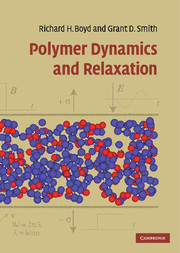Preface
Published online by Cambridge University Press: 10 November 2009
Summary
Polymers have become widely used materials because they exhibit an enormous range of behaviors and properties. They are most often processed or shaped as viscous melts. They can be used as stiff solid materials in the glassy or semicrystalline state. The rubbery or elastomeric state, obtained by cross-linking melts, is characterized by very high reversible extensibility and is unique to polymeric molecular organization. In addition, many applications are dependent upon the exhibition of behavior intermediate between that of the viscous melt and that of the relatively rigid glassy state. That is, the degree of rigidity is time dependent. In the solid state, major changes in physical properties can occur with changing temperature. Thus the same polymer can be a melt or, if cross-linked, an elastomer, or a somewhat rigid glass, or a quite rigid glass depending on the time and temperature of use. Further, these changes of properties occur in regions of time and temperature that are well defined. That is, the regions can be characterized by a variety of experimental techniques that probe the relaxation of the response following an applied perturbation such as mechanical stress or an electric field. Most polymers exhibit several such relaxation regions.
All of this rich manifold of behavior has its foundation in the ability of polymer molecules to locally change the details of the shape or conformation of the molecular chain and to accumulate these changes so that global changes in molecular shape can result.
- Type
- Chapter
- Information
- Polymer Dynamics and Relaxation , pp. ix - xPublisher: Cambridge University PressPrint publication year: 2007

